
Piazza Santo Stefano, Bologna, Italy
“Bologna is the best city in Italy for food and has the least number of tourists. With its medieval beauty, it has it all.” – Mario Batali
There are few regions in Italy more famous for food than Emilia-Romagna and the capital (but lesser traveled) city of Bologna reigns as its gastronomical heart. It is located almost midway between Milan and Florence. Its affectionate nickname, La Grassa (“the fat one”) hints at culinary treasures that await lucky visitors.
The history of Bologna began with the Etruscans. In the VI century B.C., the city bore the Etruscan name “Felsina”. Later the Romans renamed the city Bononia, from which the current name, Bologna, is derived. The original college town, La Dotta (“the learned one”) is home to the University of Bologna. This, the oldest university in the Western Hemisphere, lends a vibrant energy with progressive ideas to the ancient medieval city.
Bologna is famous for its tortellini (see L’ Erba del Re), tortelloni, tagliatelle al ragù (or, as the rest of the world calls it, Bolognese sauce – BTW, it is never served over spaghetti so don’t even go there). Italy’s greatest salumi and a wide variety of hams (prosciuttos) are at their best in Bologna. The city is so famous for its iconic sausage that Americans have taken the city name for their version. In America, what we call it bologna, is not even in the same ballpark.
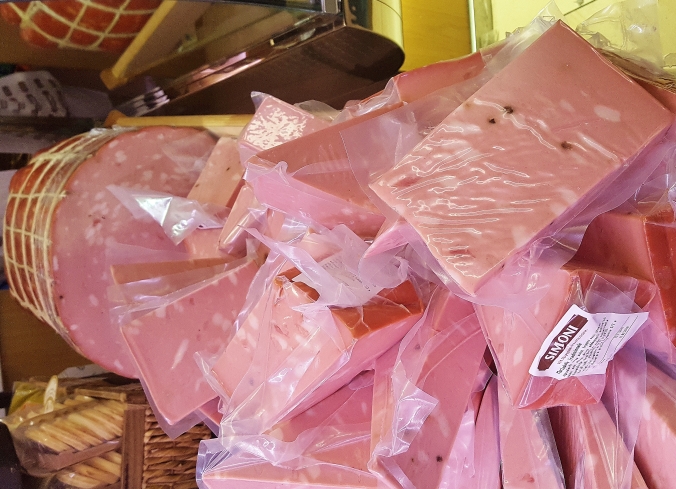
In Bologna, it is mortadella and it is taken very seriously.
Before I traveled to Bologna, I had heard about its reputation as the greatest food city in Italy – towering above the others. That’s what serious eaters have made of it for decades, so obviously I had to find out for myself.
After careful consideration, Karel and I chose a walking tour with Taste Bologna to guide us through a one-day introduction to all that was good to eat in Bologna. We are very happy that we did – it was quite simply a wonderful way to experience the amazing cuisine of the city. Our guide was Sara Flammini and since it was mid-week and off-season, there were just the three of us. We were able to easily go into small spots which large groups may not have managed. Sara’s knowledge of the food history and Bologna traditions was fascinating but she also told us a lot of interesting facts and legends about the city’s history. It gave us our bearings in the city and inspiration for many future trips.
Our morning began with coffee of course – but not just any coffee. Sara introduced us to Aroma which had recently won the prize for the best artisan cafeteria (coffee shop) of 2017. It was on a small porticoed street that led from Piazza Malpighi into Piazza Maggiore. The room was small with dark wood furniture – the effect was a pleasantly intimate atmosphere and the classical music in the background was perfect.
The owners, Alessandro and Cristina, select coffee beans from the finest artisanal roasters throughout the world, grind them, develop incredible blends, and conjure coffee drinks that defy comparison.
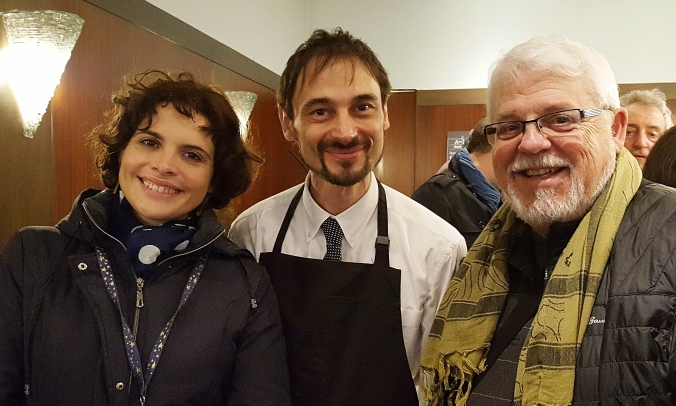
Our guide Sara Flammini, Alessandro and your humble scribe at Aroma.

The menu at Aroma.
Aroma was an ideal venue to discover varied and complex coffees in total tranquility, enabling a relaxed and different breakfast. The service was competent and friendly and always with a smile.

Caffe allo Zabaione
I selected Caffé allo Zabaione (the concept blew my mind – coffee with zabaione??). It was made from espresso with zabaione and cocoa powder. The combination of rich espresso and eggy zabaione cannot be described and I loved it!

Caffe Torinese
Karel picked the Torinese which was espresso with chocolate and cream. It sounded like Starbucks Caffe Mocha but it sure didn’t taste like it. The flavors were intense, inventive and pure. Forget it Starbucks, they are way above your league.
Now that we were suitably fortified and amped up, Sara led us to the Mercato delle Erbe. In this historic indoor market, we wondered among stalls of fresh produce, meat, fish, cheese, and other Italian provisions next to locals stocking up on ingredients for their evening meal.


Cantina DaVittorio
We made a quick stop at Cantina DaVittorio to sample various olive oils and Aceto Balsamico Tradizionale. The taste of this 25-year-old elixer was so intense that I only needed to taste one drop and the flavor simply “exploded” in my mouth.
Our next stop was across the street at Le Sfogline, a pocket-size pasta shop where locals line up for tortellini made in the classic, painstaking way – by hand. This is the soft egg pasta typical of Bologna. If there is a particular dish in Bologna that Italians (and savvy tourists) travel from far and wide to enjoy, it is tortellini. These dainty dumplings have been made in and around Bologna since the 1500s.

Le Sfogline – pasta at its best!
It’s a tradition kept alive by generations of dexterous women pasta makers such as Renata Zappoli and her daughters Daniela and Monica, who own the shop. With most tortellini mass produced in factories these days, artisanal tortellini making is in danger of disappearing after the current generation of pasta mavens disappear.

The sheets of pasta dough are rolled out entirely by hand. No machines here!
At Le Sfogline, they make it look easy. After rolling out huge sheets of dough, one woman cuts the sheets into squares, while another doles out the filling—a blend of mortadella, prosciutto, pork loin, Parmigiano-Reggiano, eggs, and nutmeg. At the end of the assembly line, the squares are folded into triangles, whose ends get a pinch and squeeze to form a ring, and voilà—a tortellino is born. The perfect tortellino weighs two grams exactly.
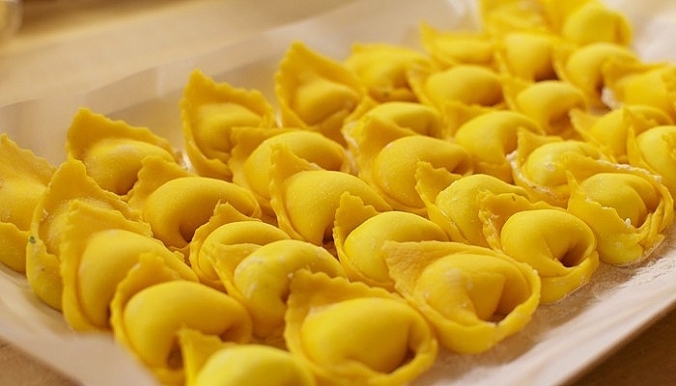
The finished product – perfect tortellini.
It will be sold the same day it was made, and if the customer is Bolognese, chances are it’s bound for brodo, a rich consommé made from capon and veal bone stock. Every day, the shop sells about 18,000 tortellini which means each of the four women churns out a staggering 4,500 at the rate of 24 per minute. This does not include their fresh tagliatelle, lasagna, and tortellini to supply the people of the city.
We were shown how to skillfully twist the small sheets of dough mixture into a perfect, plump tortellino. Thinking it looked anything but easy, I was given a piece of filled dough and tried to follow her instructions – fold, pinch, squeeze, roll. I looked at my clumsy creation, the filling oozing out from the cracks in the lining, the dough overstretched and the shape resulted in something more like a folded crepe. I will just buy mine (from Le Sfogline if possible), thank you.

A local gent shopping among the shops in the Quadrilatero
Sara next led us through the Quadrilatero – a small, rectangular grid of streets and cobblestone walkways off the Piazza Maggiore. Here was the home of a host of markets, many that spill out onto the street offering a bounty of meats, cheese, fish, fruits, and vegetables – the staples of Bolognese cuisine.

An unbelievable selection of hams, salumi, and cheeses at Salumeria Simoni.
Nearby was the Mercato di Mezzo – an ancient marketplace refurbished into a food mall. One of the best shops that specialized in hams, salumi, and cheeses was Salumeria Simoni. Sara ended up buying most of our lunch there.
In a busy corner shop, we were introduced to RoManzo, the union of the Macelleria Zivieri butchery and the kitchen of Fabio Fiore, owner of the Quanto Basta restaurant.
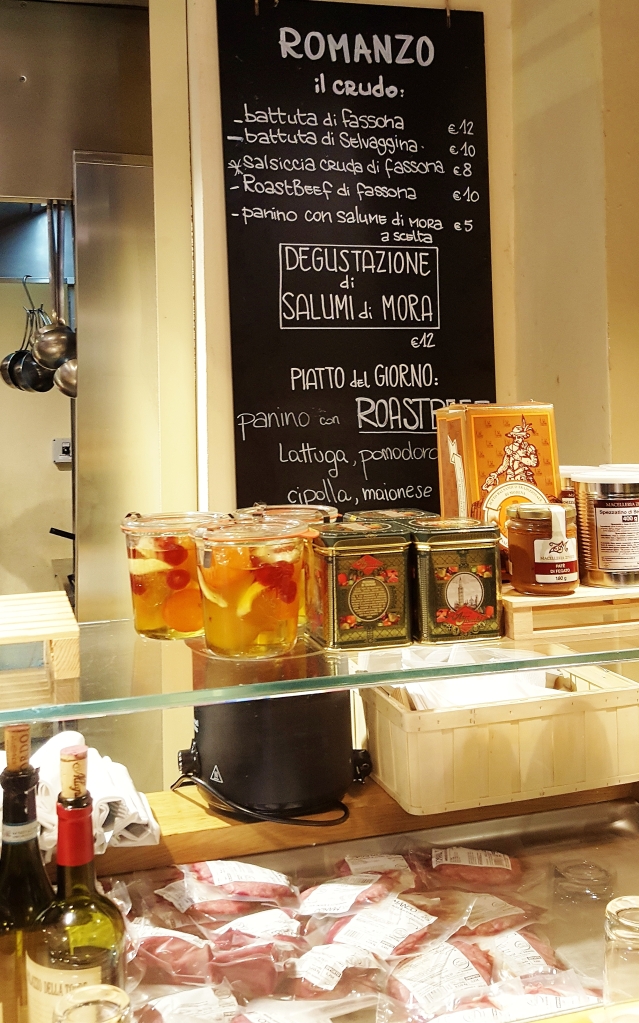 Here we were able to taste (and buy) the meats and salumi of the Zivieri Butchery crudo (raw) or cooked. Sara had arranged for us to sample the ragu – the true Bolognese product, similar but distinctly different from any that I had previously sampled. Yes, please!
Here we were able to taste (and buy) the meats and salumi of the Zivieri Butchery crudo (raw) or cooked. Sara had arranged for us to sample the ragu – the true Bolognese product, similar but distinctly different from any that I had previously sampled. Yes, please!

Ragu (or as it is known in the US, Bolognese sauce) – this is authentic as it gets, folks.
Together we selected Bolognese delicacies throughout the morning before we headed to the last true Osteria (del Sole) in the Quadrilatero to experience a slice of Bologna life as it has been for decades. We couldn’t actually order food there but were expected to buy a glass of wine or beer. We could, however, bring our own food (BYOF) and we did.
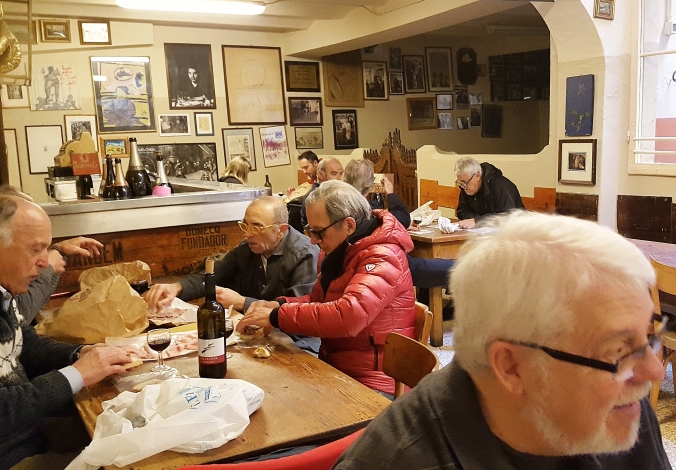
Lunchtime.
Osteria del Sole is the oldest Italian osteria still in operation today. Dating back to 1465, everything in the place is over 500 years old. Sara told us that the walls were recently painted due to excessive nicotine staining but everything else is as old as dirt or is preserved in a manner that gives off an older-than-dirt appearance – and yes, that is a compliment. There was no sign outside the door that says Osteria del Sole or any indication that there is an osteria there (that would be too easy). It’s the kind of place I would read about and want to visit but is difficult to find and (from the outside) does not look too inviting. Luckily Sara was with us to show the way.
There are a few different ways to indicate an ‘eatery’ in Italy. A ‘ristorante’ is usually a more elegant, formal dining experience with a printed menu, more expensive plates, and wine served only by the bottle. A ‘trattoria’ is somewhere in between a ‘ristorante’ and an ‘osteria’ – it’s casual, there may or may not be a printed menu, house wine is served in a decanter and the food is modest. An ‘osteria’ is probably the closest thing Italians have to a ‘pub’ or a ‘tavern’ – it’s primarily a place for drinking wine and food may or may not be present. Traditionally, osterias are no-frills, hole-in-the-wall kinds of places. Today trattorias and osterias are pretty much interchangeable.

Step up to the bar, friends. The drinks are on me.
Inside the front door, we found the bar was stocked with a variety of wine, both red and white, beer on tap, and Italian liqueurs and digestives such as Amari. There was no host or hostess so we found a table and seated ourselves.
I really liked the concept of the tour, which involved grocery shopping with Sara and later eating the bounty. Not only is the food part of Italian culture, but also how you eat it. Italians do sit around a table, chat and have fun whilst eating; this is exactly what we did.

Now, this is a charcuterie plate!
After ordering our wine, Sara spread out all of the delicious meats, cheeses, bread and condiments that she had bought for us along the way. As it turned out, we could eat only about half of it and were given the rest to take home. By the time we left, the place was beginning to fill up with locals (with their own food) cueing up to the bar for a glass of wine.
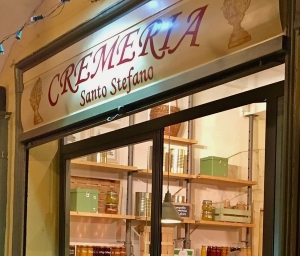 Finally, we waddled over to Cremeria Santo Stefano, a gelateria hidden behind Piazza Santo Stefano. Everyone has their own opinion of who makes ‘the best gelato in Italy. After going to some of the most well-known gelaterias in Modena and Florence (reputed to be home of the best in Italy), this was hands down, the finest.
Finally, we waddled over to Cremeria Santo Stefano, a gelateria hidden behind Piazza Santo Stefano. Everyone has their own opinion of who makes ‘the best gelato in Italy. After going to some of the most well-known gelaterias in Modena and Florence (reputed to be home of the best in Italy), this was hands down, the finest.
 They make the most sophisticated gelatos that I have ever tasted. It is customary in Italy to use high-quality ingredients, but at Cremeria Santo Stefano, they take it to a higher level. They use many DOP/IGP products because they know that the best hazelnuts come from Piedmont and the best lemons from Sorrento, etc. I read that the owner is certified by Valrhona as a chocolatier. I would not be surprised if they had a real cow in the kitchen that was happily kicking out fresh cream.
They make the most sophisticated gelatos that I have ever tasted. It is customary in Italy to use high-quality ingredients, but at Cremeria Santo Stefano, they take it to a higher level. They use many DOP/IGP products because they know that the best hazelnuts come from Piedmont and the best lemons from Sorrento, etc. I read that the owner is certified by Valrhona as a chocolatier. I would not be surprised if they had a real cow in the kitchen that was happily kicking out fresh cream.

Madagascan chocolate, stracciatella, salted caramel with cinnamon cookies……well, why not?
I think I had a mild emotional experience! We quickly became gelato aficionados and searched out the best while we were in Italy. We definitely need to go back to further our research.
Ciao!
I thought you might have retired!
LikeLiked by 1 person
I only took a brief break for Christmas. Back at it now.
LikeLike
We went to Bologna about ten years ago but now I know we have to go again! Thank you Walter!
LikeLiked by 1 person
Thanks, Barbara. When you plan your trip, let me know. I will be happy to share some ideas with you.
LikeLike
My Italian grandmother made her own tortellini. I loved to watch her deftly fill, fold and pinch it. She swore tortellini in homemade broth could cure anything. Such fun to read. It sounded like a wonderful insider to Bologna tour.
LikeLiked by 1 person
We had tortellini en brodo several times this trip and last time. I agree with your grandmother. I am sure she taught you the method! Why haven’t you served it to us?
LikeLike
This entry is tough to read on a colonoscopy prep day….Everything looks so wonderful… especially when you are hungry!
LikeLiked by 1 person
You obviously need some tortellini en brodo.
LikeLike
after reading your post, I’m going to Bologna …
LikeLiked by 1 person
I think you would have a great trip.
Just wait until I get around to writing my post about Alba!
LikeLike
Fantastic post Walt . I need to put this on a to do list between diving trips !
LikeLiked by 1 person
You would enjoy it. The medieval architecture is awesome.
LikeLike
I’ve missed your posts. This one was incredible! Italy hasn’t been on the top of our travel list, but after this, maybe it will be. Thanks.
LikeLiked by 1 person
Thanks, Jane. I was just taking a break during Christmas. I am resuming now but more like once every couple of weeks instead of every week.
LikeLike
Pingback: Trattoria Battibecco | UPROOTED
Pingback: A Tale of Two (Wine) Cities | UPROOTED